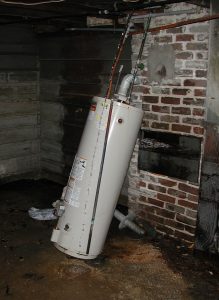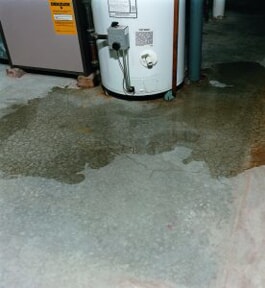Hot water runs through homes via a water heater, supplying misty, hot streams through your shower head, a sanitizing mix of hot and warm during dishwasher cycles, and temperate water into your kitchen sink. Hot water is invaluable. You control the temperature of heated water when you set the thermostat to anywhere from 120 degrees to 140 degrees Fahrenheit. Thermostats set to 140 degrees Fahrenheit or fewer limits scalding and saves on expenses.
How Do Water Heaters Work?
The way water heaters work is that water in the home is heated in a cylindrical, metal tank. After heated, the water is pulled from the water heater and runs throughout the hot water pipes to the rest of the home. Less frequently seen is the water heated by a boiler. Even less common are the initially expensive but cost-effective stand-alone water heaters, or tankless units, that supply hot water instantly. Tankless water heaters can last over 20 years, according to experts. The following information focuses on the tank system, the most common type of water heater found within homes.
Water heaters utilizing the tank system typically last anywhere from 8-12 years. The older the tank, the greater the likelihood it will spring a leak or malfunction. If you’re in store for a new water heater, experts recommend a tankless water heater. Look for manufacturers who offer lifetime warranties against leaking from their tankless units.
2 Kinds of Water Heaters: Electric and Gas
There are 2 kinds of water heaters: electric and gas. The heated water in both is controlled by a thermostat. The difference, however, is that a gas-fueled water tank may last for a much briefer time than an electric one. Why? A gas-powered water heater heats the tank itself, which in turn heats the water inside. As a result, the tank experiences a cycle of normal wear and tear, shortening its life expectancy in the process.
In either a gas or electric water heater, the unit could potentially leak—even if it is well maintained. Puddles of water inside a home are dangerous for many reasons. Excessive moisture encourages the growth of toxic mold spores, a health hazard in itself. Water buildups lead to damaged floors, walls and surrounding fixtures. In extreme cases, a major flood inside home results in a hefty water damage cleanup.
How to Check for Water Heater Leaks
To check for water heater leaks, perform a test to determine if the water droplets are simply condensation or due to a definite leak.
- Condensation is normal, especially in damp weather or in a basement.
- Wipe away the moisture with a towel.
- Place a paper towel underneath the pipes and the area where you first noticed the water. Every few hours, check to see if the towel is damp.
- If, after a few days of monitoring the situation, you find the paper towel remains dry, then normal condensation is to blame. However, if the towel is wet again, with no other visible source to cause the dampness, then the water heater has sprung a leak.
A water heater may leak due to numerous reasons. If you are familiar with plumbing and have tackled water pipes, you may be able to handle the leak yourself by tightening specific, loose valves or bolts. Call a plumber, on the other hand, if you’re inexperienced in fixing leaks.
What to Do When Finding a Water Heater Leak
Here’s what to do if you find a water heater leak:
- Turn off the power supply to the tank to prevent additional water damage to the room.
- In an electric water heater, switch off the breaker to the water heater.
- In a gas water heater, set the switch to “off”. The cold water shut-off valve should also be turned to the “off” position in significant water leaks.
Finding the Source of the Leak

- The cold water inlet and hot water outlet connections join at the top of the tank, which could be the source of the leak. If they are present here, tightening the connections will stop the leak.
- Another possible source of the water leak is the temperature and pressure (TP) relief valve. Make sure the point at which the TP valve enters the water tank is watertight. If water drips from the TP valve, it is a cause for concern.
- The TP valve will need to be professionally replaced; or, you can consult your owner’s manual for instructions on how to install a new, functional TP valve.
- Similarly, a leak from the heater drain valve can be fixed in most situations.
Internal Leaks
Most significantly, a leak within the hot water tank calls for a replacement. The tank is wrapped in insulation, so any leaks remain unnoticeable from outside. However, an internal leak will send the water straight to the bottom of the tank. Leaks that stem from the interior of a water tank are typically caused by age and deterioration, calling for a full replacement.
No matter what the cause for the internal leak, consult the professional expertise of a plumber. Attempting to fix the water heater leak as a do-it-yourself project may result in a bigger leak or even a catastrophic flood. In the event you choose to replace the water heater, you’ll require the services of a plumber to properly dispose of the old, malfunctioning unit.
Water Damage Restoration Professionals
Ignoring your leaky water heater is disastrous. In the event, your water heater has sprung a leak and the water has seeped into the flooring or surrounding areas, contact a water damage cleanup expert. Local water damage restoration specialists are available to quickly travel to your home or business within 2-3 hours of your call. Remember that standing water wreaks serious damage to areas that absorb it.
ServiceMaster of North Texas has built a strong reputation for reliable, speedy and thorough service. We offer services to both residential homes and businesses in the Garland and Dallas communities. Experienced technicians carefully evaluate the water damage using advanced equipment, such as moisture meters to detect the level of absorption, dehumidifiers, and air movers. Once a complete assessment has been performed and the structural damage assessed, our specialists get to work to remove all water damage, returning the space to its pre-damaged condition.

